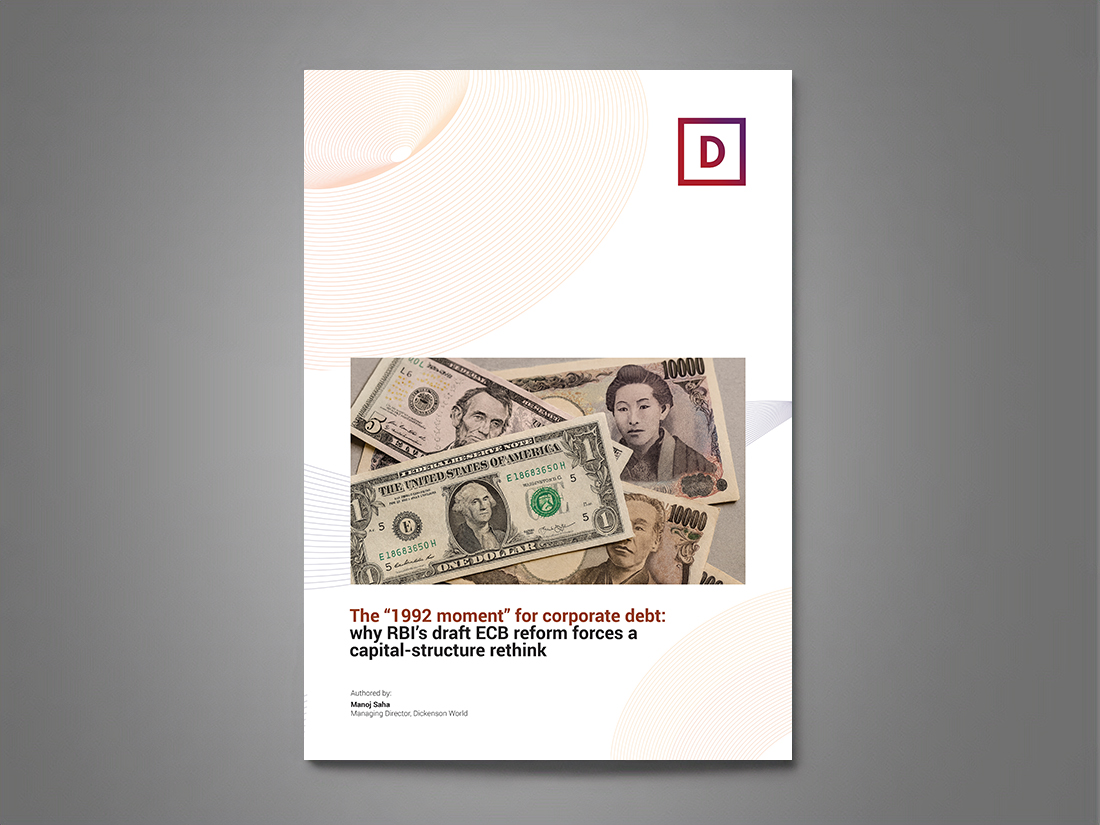The “1992 moment” for corporate debt:
why RBI’s draft ECB reform forces a capital-structure rethink
Indian corporates have long treated offshore debt with caution, governed by ceilings on cost, rigid end-use lists and fragmented approvals. On October 3 2025, the Reserve Bank of India placed in the public domain a draft overhaul of the External Commercial Borrowing framework under FEMA, proposing a ruleset that is broader, market-linked and materially simpler. It is only a draft today, yet the direction of travel is unmistakable, and consultation is open through October 24 2025.
The consequence for issuers is strategic. This package aligns pricing to markets, ties borrowing headroom to balance-sheet strength, and permits uses of proceeds that were historically out of bounds, including M&A. For CFOs, treasury heads and boards, this is the point where capital structure policy must be rewritten.
What has changed and why it matters
-
Pricing becomes market-determined:
The draft removes the prescriptive “all-in cost” caps and permits interest and fees to be set by market conditions, subject to the authorised dealer’s satisfaction. Short-dated borrowings with less than a three-year average maturity would still observe the trade-credit cost ceiling. This closes a long-standing gap with global practice and should sharpen pricing for well-rated issuers.Implication for issuers. Funding curves can now reflect true credit quality and tenor. The arbitrage between onshore NCDs and offshore loans narrows. Disclosure will need to explain pricing policy, approval thresholds and covenants under a market-rate regime.
-
Borrowing headroom linked to financial strength
The ceiling would move to the higher of: outstanding ECB up to USD 1 billion or total outstanding borrowings, domestic plus external, up to 300 percent of net worth, with no ceiling for entities regulated by RBI, SEBI, IRDAI or PFRDA. This replaces the blunt annual cap and rewards stronger balance sheets with greater flexibility.Implication for issuers. Leverage strategy becomes a calibrated function of audited net worth. Sensitivity tables in MD&A should be rebuilt around the 300 percent test and USD 1 billion reference point, with board-approved guardrails.
-
End-use liberalisation that explicitly enables acquisitions
The negative list is narrowed. The draft expressly opens acquisition f inancing and the funding of mergers, amalgamations and schemes of arrangement. On-lending is rationalised, and prohibitions stay only for activities such as chit funds, Nidhis and trading in TDRs. Treatment of real estate is aligned with what is permitted under the FDI policy. This is the most far-reaching functional change in the regime.Implication for issuers. Strategics gain a financing tool long dominated by financial sponsors. Consolidation programmes in fragmented sectors can be executed with offshore term money, subject to prudence on currency and covenant structure.
-
Maturity and access are standardised and widened
Minimum average maturity is standardised at three years for all ECBs, with a shorter one-to-three-year range only for manufacturing sector ECBs up to USD 50 million per financial year. The eligible borrower universe broadens beyond FDI-eligible companies to cover a wide set of India-incorporated entities, including REITs, InvITs, LLPs, funds, registered societies and trusts, and entities under a court-approved restructuring plan. Recognised lenders are also widened, including certain related-party lending at arm’s length.Implication for issuers.More groups and vehicles can borrow directly. Governance needs to address intra-group pricing, transfer-pricing compliance and conflicts.
-
Reporting is simplified and event-based
Monthly ECB-2 returns give way to event-based reporting of drawdowns and debt service within 30 calendar days. Changes to terms are to be filed in a revised form within 30 days – the compliance cadence shifts from calendar to transaction.Context and timing. These ECB proposals sit alongside a broader RBI clean-up and consolidation of regulations announced this month, and come with a firm consultation window to October 24 2025.
The CFO imperative: discipline over optionality
The draft regime replaces rigidity with freedom. Freedom raises the bar for risk control.
Currency risk. A larger share of foreign-currency liabilities will demand a clear hedging policy, disclosure of natural hedges and an explicit tolerance for unhedged positions. Pricing benefits can evaporate in a volatile rupee.
Covenant architecture. Market-determined pricing comes with tighter covenant packages and springing tests. Boards should set ex-ante red lines and disclosure triggers around leverage, interest cover and DSCR.
Disclosure and governance. With M&A and on-lending opened, related-party safeguards, transfer-pricing documentation and audit trails must be strengthened. Annual Report sections on capital management, financial risk and related-party transactions will need precise updates.
Immediate actions for CFOs and boards
-
Re-base borrowing policy. Map existing debt headroom to the proposed “USD 1 billion or 300 percent of net worth” test; prepare an internal cap and approval matrix by tenor and currency.
-
Refresh the treasury playbook. Define hedging thresholds, instruments and counterparties; link to a board-approved risk appetite statement that survives auditor scrutiny.
-
Stand up an M&A financing lane. Create a covenant and collateral term sheet for acquisition finance and distressed assets, including information undertakings and step-in rights.
-
Prepare disclosures. Draft MD&A and Risk section inserts that explain the market-rate regime, maturity policy, and the treatment of foreign-currency risks, with quantitative sensitivities.
-
File a consultation response. If your sector has unique needs, submit comments via the RBI onsultation channel before October 24 2025; record the submission in governance minutes.
A final word
In 1992, the equity market’s reform reset how Indian issuers accessed capital. This draft ECB framework does the same for foreign debt. If implemented substantially as written, it will lower friction and align India’s corporate funding architecture with global norms. The opportunity is sizeable. So are the execution risks. The onus now sits with corporate leadership to convert optionality into durable value through policy, controls and disclosure.
Contact Us: To learn more or schedule a consultation, please reach out to us at www.dickensonworld.com
Email:enquiry@dickensonworld.com.
About the Author
With over 25 years of experience in corporate finance and a deep-rooted understanding of ESG imperatives, Manoj Saha brings a wealth of knowledge to the discourse on corporate governance. Educated in the UK in Accountancy & Finance, he has dedicated his career to guiding organizations through the intricacies of financial management and stakeholder engagement across global markets, including India, the USA, the UK, and the Middle East and North Africa (MENA) region.

The “1992 moment” for corporate debt
To download and save this article.
Authored by:
Manoj Saha
Managing Director, Dickenson World
Visit www.dickensonworld.com to learn more about our services and how we can help streamline your corporate reporting process.


Leave A Comment